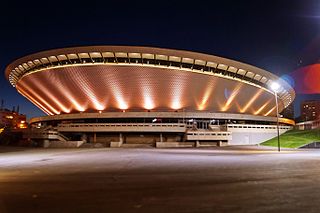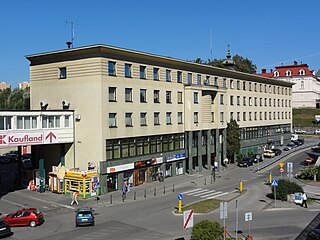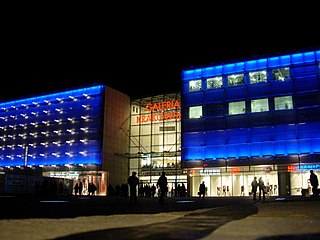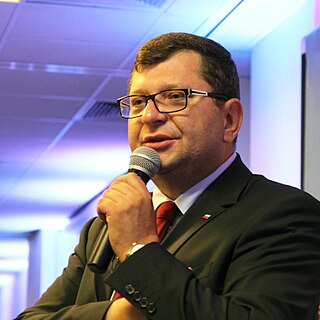
Katowice is the capital city of the Silesian Voivodeship in southern Poland and the central city of the Katowice urban area. As of 2021, Katowice has an official population of 286,960, and a resident population estimate of around 315,000. Katowice is a central part of the Metropolis GZM, with a population of 2.3 million, and a part of a larger Katowice-Ostrava metropolitan area that extends into the Czech Republic and has a population of around 5 million people, making it one of the most populous metropolitan areas in the European Union.

Bytom is a city in Upper Silesia, in southern Poland. Located in the Silesian Voivodeship of Poland, the city is 7 km northwest of Katowice, the regional capital.

Bielsko-Biała is a city in southern Poland, with a population of approximately 166,765 as of December 2022, making it the 22nd largest city in Poland, and an area of 124.51 km2 (48.07 sq mi). It is the core of the broader metropolitan area with around 335,000 inhabitants. It serves as the seat of the Bielsko County, Euroregion Beskydy, Roman Catholic Diocese of Bielsko–Żywiec and the Evangelical Church Diocese of Cieszyn.

Tomaszów Mazowiecki is a city in central Poland with 60,529 inhabitants (2021). It is the fourth most populous city in the Łódź Voivodeship and the second with free public transport. It is the seat of Tomaszów County. In Tomaszów Mazowiecki there is the first all-year speed skating track in Poland - Ice Arena Tomaszów Mazowiecki, which has hosted the World Championships. In autumn, the city hosts the international Love Polish Jazz festival, organized by the Polish Ministry of Culture and National Heritage.

The Metropolis GZM is a metropolitan association composed of 41 contiguous municipalities in the Silesian Voivodeship of Poland. The seat of the metropolitan council is Katowice, the largest member city and the voivodeship capital. With a population of over 2 million, the core of the Metropolis GZM is one of the largest urban areas in the European Union. The area of the metropolis largely coincides with the metropolitan area of the Katowice urban area, which is a part of the wider cross-border Katowice-Ostrava metropolitan area, the latter with a population of 5–5.3 million people.

Cieszyn County is a unit of territorial administration and local government (powiat) in Silesian Voivodeship, southern Poland, on the Czech and Slovak border. It came into being on January 1, 1999, as a result of the Polish local government reforms passed in 1998.
Mirdif is a residential area located in Dubai, United Arab Emirates.

Katowice railway station is a railway station in Katowice, Silesia, Poland, and the largest railway station in the Upper Silesian Industrial Region. Domestic and international trains connect at the station to most major cities in Europe; these are operated primarily by Polskie Koleje Państwowe.

Expressway S86 – built from 1978 to 1986 section of national road 86 with a length of 5.9 kilometres (3.7 mi), connecting Katowice with Sosnowiec. In Katowice the road is a part of Walentego Roździeńskiego Avenue. The route has two carriageways with three lanes on each other.

TVP3 Katowice a.k.a. TV Katowice also Television Katowice is one of the regional branches of the TVP, Poland's public television broadcaster. It serves the entire Silesian Voivodeship with particular dedication to the Metropolis GZM and Katowice metropolitan area.

Galeria Krakowska is a shopping mall in Kraków, Poland, located adjacent to the city's main railway station.

Sarajevo City Center (SCC) is a business complex and shopping center in downtown Sarajevo, Bosnia and Herzegovina, that consists of three main parts: a shopping mall and leisure complex; a five star hotel tower; and a commercial offices tower, with a common 4-storey underground parking area with more than 1100 parking spaces.

Paweł Wiktor Graliński, a Polish architect, was born on January 10, 1961, specializing in planning and design of mixed-use developments and commercial and entertainment centres in Poland and Europe.

Zbigniew Stonoga is a Polish entrepreneur, businessman, activist and philanthropist who gained notoriety as a whistleblower for the publication of the investigation files concerning the Polish bugging scandal (2014–2015), known as Waitergate. Founder of the short-lived Stonoga Party Poland. Founder of Gazeta Stonoga.

The Katowice massacre or the Bloody Monday in Katowice that took place on 4 September 1939 was one of the largest war crimes of the Wehrmacht during its invasion of Poland. On that day, German Wehrmacht soldiers aided by the Freikorps militia executed about 80 of the Polish defenders of the city. Those defenders were self-defense militia volunteers, including former Silesian Insurgents, Polish Boy and Girl Scouts, and possibly a number of Polish soldier stragglers from retreating Polish regular forces who joined the militia.

The Defense of Katowice was carried out by small groups of irregular Polish militia on 3–4 September 1939 during the German invasion of Poland. German troops secured the city by the end of 4 September.

The Autonomy March is a demonstration that has taken place annually since 2007 around the 15th of July in Katowice, Upper Silesia, Poland. It consists of a march through the streets of Katowice in front of the Voivodeship Office. According to the organizers, the March is a manifestation of support for the idea to restore autonomy to Upper Silesia in a modern form, modeled on Spanish or German solutions.

KTW is a complex of two high-rise buildings in Katowice, Poland. KTW I, the first building of the project, was completed in 2018 at 66 metres (217 ft). The second tower, KTW II, rises 134 metres (440 ft) and was finished in 2022; it is the tallest building in Katowice and in the Upper Silesia region.

The Silesian Separatist Movement was a minor Silesian party that advocated for Silesian independence from Poland. The party was founded on 19 March 2007 by Silesian activists Dariusz Jerczyński, Grzegorz Kot and Marcela Tampa. The party was affiliated with a Silesian regionalist organisation People of the Silesian Nation and the Silesian Autonomy Movement, and Grzegorz Kot ran for the Senate of Poland in the 2007 Polish parliamentary election on behalf of this party. Silesian Separatist Movement listed "national and territorial separation of Silesia from Poland" and "the sanctioning of Silesian nationality" as its main goals. According to its program, the party was dedicated to the concept of an independent Silesian state in tradition of interwar Silesian movements such as Silesian People's Party (1908-1938) and the Union of Upper Silesians (1919-1924), which wanted to realise this concept. In May 2010, the movement was put into liquidation, and was removed from the Register of Associations on June 6th.

Szwedzki is the pseudonym of a street artist active mainly in the Silesian Voivodeship, creator of murals and graffiti. It is also the name of the character in his typically humorous murals, depicting the same comic-style figure in blue pants and a yellow shirt.


















